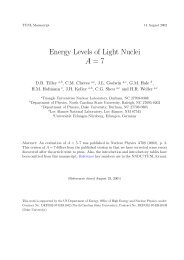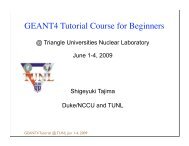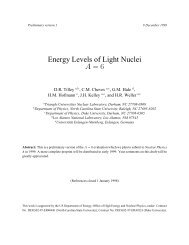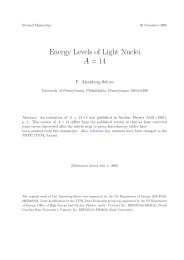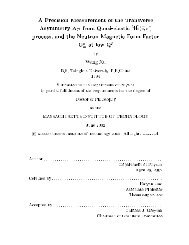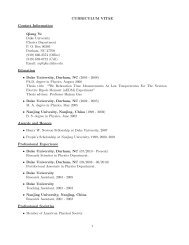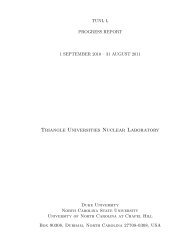Introduction to Nuclear reactions
Introduction to Nuclear reactions
Introduction to Nuclear reactions
Create successful ePaper yourself
Turn your PDF publications into a flip-book with our unique Google optimized e-Paper software.
<strong>Introduction</strong> <strong>to</strong><br />
<strong>Nuclear</strong> <strong>reactions</strong><br />
G.J. Weisel<br />
Penn State Al<strong>to</strong>ona<br />
June 12, 2006<br />
Hodgson, Gadioli, and Erba, Introduc<strong>to</strong>ry <strong>Nuclear</strong> Physics (1997)<br />
N.A. Jelley, Fundamentals of <strong>Nuclear</strong> Physics (1990)<br />
K.S. Krane, Introduc<strong>to</strong>ry <strong>Nuclear</strong> Physics (1988)<br />
G.R. Satchler <strong>Introduction</strong> <strong>to</strong> <strong>Nuclear</strong> Reactions (1990)
Notation for scattering experiment<br />
a<br />
X<br />
b<br />
Y<br />
a + X --> b + Y<br />
X(a,b)Y<br />
incoming particle (from source)<br />
target nucleus<br />
outgoing particle (detected)<br />
residual nucleus
Examples of nuclear <strong>reactions</strong>:<br />
Fission<br />
Fusion<br />
Elastic<br />
Inelastic<br />
Pickup<br />
Stripping<br />
Capture<br />
Pho<strong>to</strong>disintegration<br />
(n,2nγ) <strong>reactions</strong><br />
n + 235 U --> 2n + 93 Rb + 141 Cs<br />
3 H(d,n) 4 He<br />
208 Pb(n,n) 208 Pb<br />
208<br />
Pb(n,n') 208 Pb<br />
208 Pb(p,d) 207 Pb<br />
208<br />
Pb(d,p) 209 Pb<br />
3<br />
He(α,γ) 7 Be<br />
3 He(γ,p) 2 H<br />
179<br />
Hf(n,2nγ) 178 Hf
Scattering experiment is done in lab frame<br />
but data is reported in center of mass frame<br />
Lab system<br />
Classically:<br />
v cm<br />
= (m a<br />
v a<br />
)/(m a<br />
+ m x<br />
)<br />
Center of Mass system
Cross Section, σ<br />
σ = “effective area” of a target nucleus for a certain reaction<br />
Units are barns, b = 10 -28 m 2 (or mb = 10 -31 m 2 )<br />
The <strong>to</strong>tal effective area of all nuclei in target = σ (nAt)<br />
Rate of reaction<br />
= (incoming beam rate) x (<strong>to</strong>tal effective area) / (area of the target)<br />
R reaction<br />
= N i σ (nAt)/A = N i<br />
σ nt
Differential cross section, σ(θ)<br />
Α cross section per solid angle, σ(θ), or dσ/dΩ, with units of mb/sr<br />
∆Ω = solid angle of detec<strong>to</strong>r (sr)<br />
Total steradians in a sphere = 4π<br />
∆A = area of detec<strong>to</strong>r face<br />
∆Ω = 4π ∆A/(4πr 2 ) = ∆A/r 2<br />
R detec<strong>to</strong>r<br />
= N i<br />
[σ(θ) ∆Ω] (nAt)/A = N i<br />
[σ(θ) ∆Ω] nt
Q Value<br />
X(a,b)Y<br />
Define Q value as a “mass difference”:<br />
Q = (m Y<br />
c 2 + m b<br />
c 2 ) - (m X<br />
c 2 + m a<br />
c 2 )<br />
From energy conservation (target X initially at rest):<br />
m X<br />
c 2 + m a<br />
c 2 + K a<br />
= m Y<br />
c 2 + m b<br />
c 2 + K Y<br />
+ K b<br />
Therefore, we also can think of Q as change in K <strong>to</strong>tal<br />
:<br />
Q = (K Y<br />
+ K b<br />
) - K a
For positive Q values, energy is released (exothermic)<br />
Fission<br />
Fusion<br />
n + 235 U --> 2n + 93 Rb + 141 Cs<br />
Q = 181 MeV<br />
3 H(d,n) 4 He<br />
Q = 17.6 MeV<br />
For negative Q values, reaction threshold = -Q (endothermic)<br />
Pickup<br />
(n,2n)<br />
208 Pb(p,d) 207 Pb<br />
Threshold = 5.17 MeV<br />
179<br />
Hf(n,2n) 180 Hf<br />
Threshold = 6.09 MeV
Rutherford Scattering<br />
Scattering from Coulomb field<br />
Differential cross section, σ R<br />
(θ),<br />
is forward peaked.<br />
Rutherford worked on<br />
197 Au(α,α) 197 Au.<br />
Similar results for large enough<br />
charge or low enough energies.<br />
208<br />
Pb( 16 O, 16 O) 208 Pb
<strong>Nuclear</strong> elastic scattering<br />
Using higher-energy and/or smaller-charged projectiles,<br />
we see nuclear scattering.<br />
Divide the measured differential cross section by the theoretical<br />
Rutherford cross section.<br />
σ(θ)/σ R<br />
(θ) for (p,p) elastic scattering<br />
shows diffraction-like pattern!<br />
Incoming “wave” of pro<strong>to</strong>ns of<br />
de Broglie wavelength λ = h/p<br />
At E p<br />
= 10 MeV, λ = 9 fm
¡<br />
£<br />
Partial Wave Analysis<br />
of nuclear scattering<br />
Represent incoming particle beam as a plane wave<br />
with de Broglie wavelength λ = h/p.<br />
Assume solution <strong>to</strong> Schroedinger equation depends only on r and θ.<br />
For a central force, assume the form of the solution at infinity is:<br />
(Solution) = (Plane wave) + (Scattered spherical wave)<br />
(Scattered wave) = λ/(4πi)<br />
Σ (2<br />
+1) P<br />
(cosθ) (exp(2iδ<br />
) – 1),<br />
where P<br />
¢(cosθ) are “Legendre polynomials.”<br />
The δ<br />
¢, or “phase shifts,” are determined via curve fitting or modeling.<br />
The lower the energy, the fewer<br />
values are needed.
Direct vs. Compound nuclear <strong>reactions</strong><br />
Direct: Incoming particle either<br />
scatters elastically (shape elastic) or<br />
only “grazes” target, interacting with<br />
nucleons at surface.<br />
Interaction time around 10 -22 s.<br />
Compound: A two-step process.<br />
First, incoming particle enters target<br />
and forms a compound nucleus.<br />
Then, compound nucleus ejects<br />
particle(s).<br />
Interaction time around 10 -16 s.<br />
Direct scattering “remembers”<br />
beam direction; its differential<br />
cross section is forward peaked
Compound Reactions<br />
a + X --> C* --> b + Y<br />
Independence hypothesis:<br />
The decaying compound nucleus, C*<br />
has no “memory” of how it was formed.<br />
Excitation functions; graphs of σ vs.<br />
incoming particle energy.<br />
dotted line: 63 Cu(p,n) 63 Zn<br />
63<br />
Cu(p,2n) 62 Zn<br />
63 Cu(p,pn) 62 Cu<br />
60<br />
solid line: Ni(α,n) 63 Zn<br />
60<br />
Ni(α,2n) 62 Zn<br />
60 Ni(α,pn) 62 Cu<br />
For both sets of experiments,<br />
we see the same resonances,<br />
reflecting states of the<br />
compound nucleus 64 Zn<br />
(“nuclear structure”)
Individual resonances of compound nucleus<br />
R-matrix (reaction matrix) analysis<br />
Match internal and external waves at<br />
boundary of nuclear potential <strong>to</strong> determine<br />
angular momentum and parity<br />
of excited states of compound nucleus.<br />
p + 26 Mg --> 27 Al --> p + 26 Mg<br />
Excitation function of σ(θ) shows<br />
resonances for states in 27 Al
(n,n'γ) and (n,2nγ) <strong>reactions</strong><br />
Neutron is captured <strong>to</strong> form compound nucleus. Then, the compound<br />
nucleus ejects neutron(s), leaving residual nucleus.<br />
Measure the energy spectrum of the gammas <strong>to</strong> identify excited states<br />
of the residual nucleus and determine the cross sections.<br />
Example:<br />
179<br />
Hf(n,2nγ) 178 Hf<br />
Reactions of<br />
interest <strong>to</strong><br />
national security<br />
(bomb design)
Direct Reaction<br />
Optical model of nuclear elastic scattering<br />
Analogy between optical scattering<br />
(complex index of refraction) and nuclear<br />
scattering (complex nuclear potential)<br />
120<br />
Sn (n,n) 120 Sn<br />
Note diffraction-like patterns<br />
The imaginary part of the nuclear<br />
potential acts as a sort of “sink hole”<br />
for all nuclear <strong>reactions</strong>. It gives σ R<br />
predictions that are smooth with energy.<br />
Therefore, the optical model cannot<br />
see nuclear structure. It is best used<br />
when the compound-nucleus channels<br />
form a continuum of <strong>reactions</strong> (above<br />
10 MeV or so).
<strong>Nuclear</strong> Optical Model Potential<br />
V(E) = (V v<br />
(E) + iW v<br />
(E)) + (V s<br />
(r) + iW s<br />
(E))<br />
volume surface<br />
Real terms, V v<br />
and V s<br />
, model elastic scattering<br />
Imaginary terms, W v<br />
and W s<br />
, are the “sink hole” for <strong>reactions</strong><br />
At relatively high energies<br />
(above 40 MeV), W v<br />
dominates<br />
At relatively low energies , W s<br />
is also important (projectiles do<br />
not penetrate nucleus as much).
Direct reaction<br />
Stripping Reaction<br />
Incoming projectile leaves a particle in well-defined state of the residual<br />
nucleus. From σ(θ) of scattered pro<strong>to</strong>ns, deduce properties of singleparticle<br />
states of residual nucleus.<br />
“Dis<strong>to</strong>rted Wave Born approximation” (DWBA):<br />
Approximate the incoming and outgoing waves with optical model<br />
representations, from analysis of elastic scattering.<br />
The “transition amplitude” is<br />
T = ∫[outgoing wave] F(r) [incoming wave] dv,<br />
where F(r), the “form fac<strong>to</strong>r,” contains the structure information.<br />
Differential cross section, σ(θ), is proportional <strong>to</strong> |T| 2 . Modify F(r)<br />
until it reproduces σ(θ)for each state of the residual nucleus.
Example of stripping reaction: 90 Zr(d,p) 91 Zr<br />
Spectrum of pro<strong>to</strong>ns (for each angle)<br />
show peaks related <strong>to</strong> states of 91 Zr<br />
Data is sorted by gating counts<br />
for each pro<strong>to</strong>n peak when<br />
graphing differential cross sections.<br />
Deduce single-particle structure<br />
information from the σ(θ) curves.
Reactions involving gamma rays<br />
Radiative Capture<br />
Target absorbs incident particle and<br />
at the same time a gamma ray is released<br />
Pho<strong>to</strong>disintegration<br />
Incident gamma ray breaks up target<br />
Inverse reaction <strong>to</strong> radiative capture<br />
Example:<br />
H(n,γ) 2 H<br />
Deuteron formation<br />
Q = 2.225 MeV (exothermic)<br />
2<br />
H(γ,n)p Deuteron breakup<br />
Threshold = 2.225 MeV (endothermic)
Radiative Capture<br />
Deduce electromagnetic transitions:<br />
from scattering state <strong>to</strong> state of residual<br />
nucleus. Many such <strong>reactions</strong> are important<br />
in nucleosynthesis. “<strong>Nuclear</strong> astrophysics”<br />
At low energies (near Coulomb barrier),<br />
it is convenient <strong>to</strong> multiply the cross<br />
section by the energy:<br />
S fac<strong>to</strong>r = σ E e -2πη .<br />
(The exponential is the “penetration fac<strong>to</strong>r.”)<br />
Example: 2 H(d,γ) 4 He<br />
Excitation function for S fac<strong>to</strong>r fit<br />
using two E2 transitions<br />
(electric transitions with ∆L = 2)
Pho<strong>to</strong>disintegation<br />
Example: 3 He(γ,p)d<br />
Excitation function<br />
for <strong>to</strong>tal cross section, σ<br />
Model incoming channel with electromagnetic interaction.<br />
For outgoing channel, do a three-body (Faddeev) calculation,<br />
based on a model of the NN interaction (Bonn, AV18, etc.)<br />
Precision σ data places constraints on the three-body computations<br />
and on the NN models.


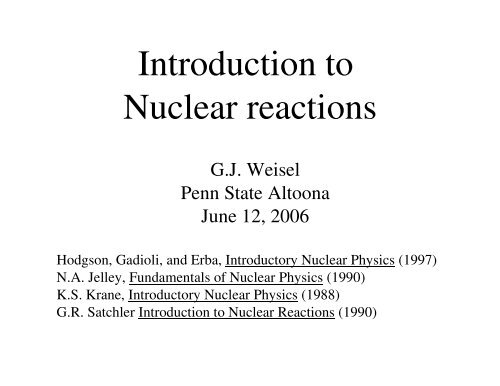
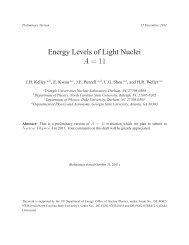

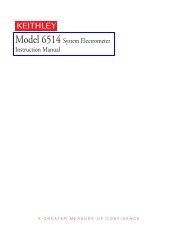
![TUNLXXXIV.tex typeset [1] - Triangle Universities Nuclear Laboratory](https://img.yumpu.com/47618358/1/190x245/tunlxxxivtex-typeset-1-triangle-universities-nuclear-laboratory.jpg?quality=85)
